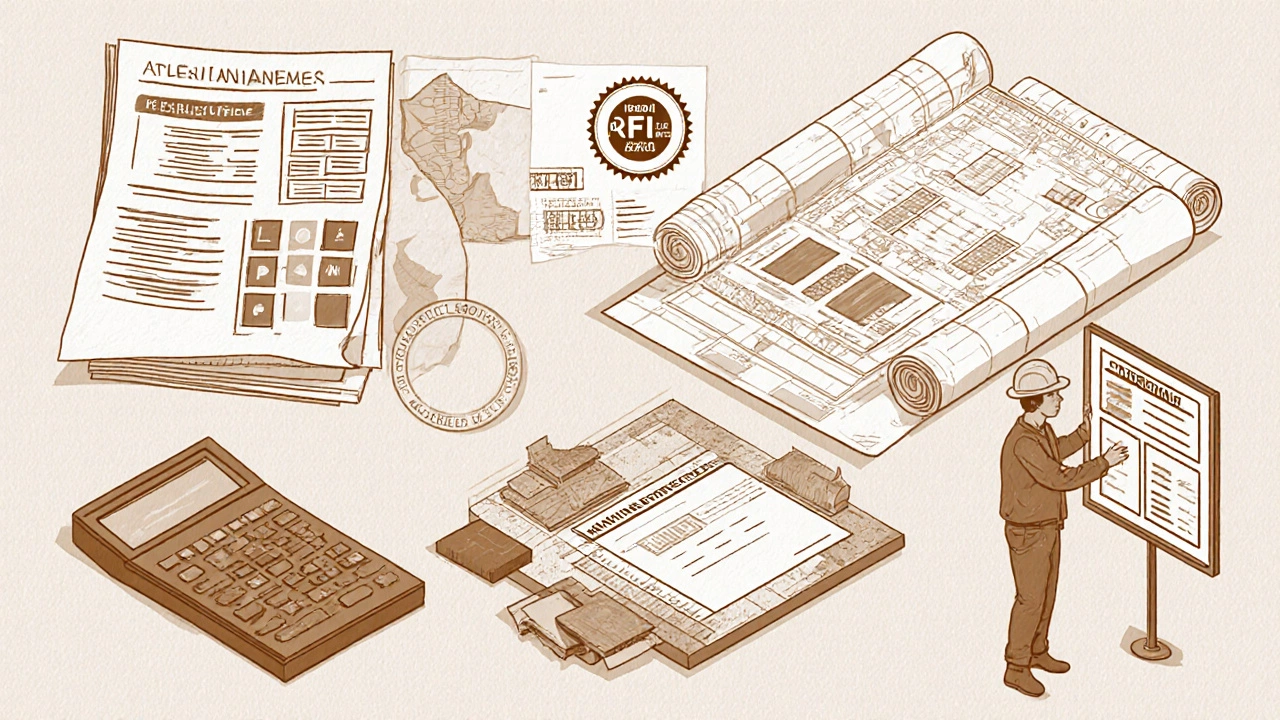What Is a Full Architectural Service? Explained

Architectural Service Cost Calculator
Calculate Your Fees
Estimated Architectural Fees
Breakdown of Full Service Fees
- Feasibility & Site Study (0.5%)
- Concept & Schematic Design (1.0%)
- Construction Documents (3.0%)
- Planning & Regulation (0.8%)
- Project Management (2.5%)
- Contingency & Value Engineering (0.5%)
Key Insight: A full service can save 5-10% on construction costs through reduced errors, better approvals, and schedule management.
Quick Takeaways
- A full architectural service covers everything from site analysis to post‑construction handover.
- It bundles design, documentation,regulatory approvals, cost control, and on‑site coordination.
- Choosing a full service can reduce delays, keep budgets tighter, and simplify communication.
- Typical deliverables include feasibility studies, construction drawings, and project‑management reports.
- Homeowners should match the service scope to project complexity and budget.
When you’re planning a new build or a major remodel, the phrase full architectural service often shows up in quotes from architects. But what does it actually include? This guide breaks down every piece of the puzzle, shows how it differs from a “design‑only” approach, and gives you a checklist to decide if it’s the right fit for your project.
First, let’s define the core concept.
Full Architectural Service is a comprehensive package that guides a building project from initial concept through construction completion, handling design, documentation, approvals, cost control, and on‑site coordination. It is the opposite of a fragmented approach where the client hires separate consultants for each stage.
Core Components of a Full Service
Below are the typical building blocks you can expect.
- Feasibility Study - an early‑stage assessment of site constraints, zoning, budget limits, and client goals
- Architectural Design - the creative process of shaping the appearance and functionality of a building
- Construction Documents - detailed drawings and specifications that contractors use to build the project
- Planning Permission - the formal approval from local authorities to commence building work
- Building Regulations - mandatory standards covering safety, energy efficiency, accessibility, and structural integrity
- Cost Estimation - a realistic budget forecast based on design intent, material choices, and market rates
- Project Management - the day‑to‑day coordination of designers, engineers, contractors, and suppliers to keep the build on schedule and on budget
- Sustainability Consulting - advice on energy‑saving measures, low‑impact materials, and certifications such as Passivhaus or BREEAM
Some architects also bundle interior design, landscape architecture, and post‑occupancy evaluation in the same contract, but the eight items above form the core of any full service offering.
How It Differs From Partial or Design‑Only Services
To see why a full service matters, compare it with more limited options.
| Feature | Full Architectural Service | Design‑Only Service | Partial / Consultant‑Only |
|---|---|---|---|
| Site Feasibility | ✔ Included | ✘ Usually omitted | Variable |
| Construction Drawings | ✔ Detailed set | ✔ Basic schematics | ✘ May need separate drafter |
| Planning Permission | ✔ Managed end‑to‑end | ✘ Client submits alone | ✘ Depends on consultant |
| Cost Estimation | ✔ Accurate budget | ✘ Rough order of magnitude | Variable |
| Project Management | ✔ On‑site coordination | ✘ None | ✘ Usually absent |
| Sustainability Advice | ✔ Integrated | ✘ Optional add‑on | ✘ Rare |
Notice how the full service ties every stage together. When you work with a single architectural firm, you avoid the “silo effect” where each consultant interprets the design differently, leading to costly revisions.
Typical Process Timeline
- Initial Consultation - discuss client brief, budget, and timeline.
- Site Analysis & Feasibility - assess zoning, utilities, topography, and constraints.
- Concept Design - hand sketches, massing models, and client feedback loops.
- Schematic Design - refined drawings, material palettes, and sustainability targets.
- Design Development - detailed sections, structural integration, and building‑services coordination.
- Construction Documents - full set of plans, elevations, details, and specifications.
- Planning Submission - prepare and submit the application, respond to authority queries.
- Cost & Value Engineering - final cost estimate, explore value‑saving alternatives.
- Construction Administration - site meetings, RFI (request for information) handling, progress inspections.
- Final Handover - punch‑list completion, as‑built drawings, client walkthrough.
Each stage builds on the previous one, and the architect’s role shifts from creative lead to technical overseer as the project moves toward construction.

Cost Considerations
Full services are usually charged as a percentage of the construction cost, ranging from 7% to 12% for residential projects. The percentage may drop for larger commercial builds because of economies of scale.
Here’s a quick cost‑breakdown example for a £250,000 single‑family home (based on 2024 market rates):
- Feasibility & Site Study - 0.5% (£1,250)
- Concept & Schematic Design - 1.0% (£2,500)
- Construction Documents - 3.0% (£7,500)
- Planning & Regulation Liaison - 0.8% (£2,000)
- Project Management (on‑site) - 2.5% (£6,250)
- Contingency & Value Engineering - 0.5% (£1,250)
- Total Approximate Architect Fee: £21,250 (8.5% of build cost)
While that looks like an extra expense, the integrated approach can save 5‑10% on construction costs by avoiding design errors, streamlining approvals, and keeping the schedule tight.
When a Full Architectural Service Is Worth It
Not every project needs the full package. Ask yourself these questions:
- Complexity: Is the site irregular, or does the brief involve mixed‑use spaces?
- Regulatory hurdles: Does the local authority have a reputation for stringent scrutiny?
- Budget certainty: Do you need a detailed cost forecast before committing to contractors?
- Time constraints: Is a fast‑track schedule essential?
If you answered “yes” to two or more, the full service is likely to pay for itself through reduced risk and smoother execution.
Choosing the Right Architect
Even within full‑service firms, experience varies. Use this short checklist when vetting candidates:
- Portfolio relevance - look for projects of similar scale and typology.
- Regulatory track record - ask how many planning permissions they have secured in your council.
- Reference checks - speak with former clients about communication and on‑site coordination.
- Fee transparency - request a breakdown matching the stages listed above.
- Sustainability credentials - verify any certifications (e.g., BREEAM, LEED) they hold.
Most reputable firms will give you a written scope of services that mirrors the list in this article, letting you compare apples‑to‑apples.

Common Pitfalls to Avoid
- Assuming “design only” means cheap. Low upfront fees often hide big overruns later.
- Skipping the feasibility study. Ignoring site constraints can lead to costly redesigns.
- Not securing planning permission early. Delays at the council stage can freeze the entire schedule.
- Under‑estimating the architect’s role during construction. Without active project management, mis‑interpretations of drawings are common.
- Overlooking sustainability. Missing out on energy‑efficiency measures now can raise operating costs dramatically.
Future Trends in Full Architectural Services
Technology is reshaping how architects deliver end‑to‑end solutions. Expect to see more BIM (Building Information Modeling) integration, virtual reality design reviews, and AI‑assisted cost estimation becoming standard parts of a full service package by 2026.
These tools improve accuracy, speed up the planning approval process, and give homeowners a more immersive preview of their future space.
Frequently Asked Questions
What exactly does a full architectural service include?
It covers everything from the initial site feasibility study, through concept and detailed design, construction documentation, planning permission handling, cost estimating, on‑site project management, and often sustainability consulting. In short, the architect stays involved from idea to handover.
How are fees usually calculated?
Most firms charge a percentage of the construction cost, typically 7‑12% for residential projects. Some may use a fixed‑price lump sum or break the fee into stage‑by‑stage percentages, which should be clearly outlined in the contract.
Can I mix a full service with specialist consultants?
Yes. Many homeowners keep the architect for overall coordination while hiring separate structural engineers, acoustics experts, or interior designers. The key is to ensure the architect’s scope explicitly includes coordination of those specialists.
What are the biggest risks of skipping the full service?
You may face design errors that require costly redesigns, delays in obtaining planning permission, budget overruns from inaccurate cost estimates, and coordination headaches on‑site that can stretch the timeline.
How long does a typical full‑service project take?
For a standard single‑family home, expect 3‑4 months for design and approvals, followed by 8‑12 months of construction. The full service runs the entire period, so the architect remains engaged for roughly 12‑16 months.